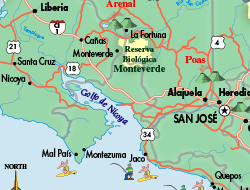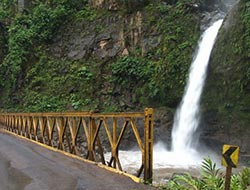See colorful carretas in Costa Rica
Costa Rica Ox Cart
The carreta, or ox cart, is a brightly colored handicraft and symbol of Costa Rica culture. Those looking to appreciate the artistic side of Costa Rica will enjoy this unique art form, and those interested in history and mechanics will enjoy seeing carretas being crafted in the traditional manner.
Ox Cart Background
The ox cart became a significant means of transportation for rural Costa Ricans after it was introduced to the area circa 1840. Farmers used ox carts in order to transport valuable crops like coffee beans or sugar cane. The carreta was valued for its ability to maneuver over all types of hazardous terrain. In spite of the name, originally it was human beings, not oxen, who pulled the carretas until the loads became too heavy. Perhaps inevitably, over the centuries cars and other motorized vehicles have replaced the ox cart as transportation. However, ox carts have gained new life as a celebrated form of artwork.
Traditional Symbol
Even if ox carts are no longer used today as a practical form of transportation, the artisans who construct carretas today are nevertheless dedicated to their craft and take a lot of pride in their work, and with good reason. The ox cart has taken on a symbolic significance, commemorating Costa Rica traditions and agricultural history, and was officially declared a national symbol of Costa Rica 30 years ago. Visitors to Costa Rica can witness carretas in all their traditional glory during the "Día del Boyero" (Day of the Drover) parade, which is held in the city of Escazú every year on the second Sunday in March.
From Practical Utility to Aesthetic Expression
Carretas are now decorated with bright colors and intricate designs. They are painted in vivid shades of red, orange, white, and blue. They often boast floral motifs, and the wheels are emblazoned with mandala-like patterns. The beauty of the carreta is not only visual, however, but also auditory. The artisans who craft carretas think about the sound that the ox cart makes as it rolls down the street and make an effort to ensure that the sound is pleasing to the ear. To that end, they painstakingly choose the pieces of wood from which the wheels will be crafted, specifically for that purpose. The wheels consist of sixteen wedge-shaped pieces of wood arranged in a circle and bound with a metal ring.
Where to Find Carretas
Even if you miss the parade in Escazú, there are other places in Costa Rica to view carretas. Indeed, decorative carretas can be found in various areas throughout the country, in restaurants or other businesses. Perhaps the best place to go and see carretas is Sarchí Costa Rica, a village in the northern province of Alajuela. While there, visitors can see the largest ox cart in the world, according to the Guinness Book of World Records. Moreover, Sarchí is famous for being the home to many beautiful ox carts of all different sizes. In fact, some small carretas are crafted specifically for purposes of home décor and are available for tourists to purchase. Before you buy, however, be aware that because these ox carts are handcrafted works of art, they may not be within the budget of every traveler.
Nevertheless, even if you are unable to purchase a carreta, in some instances the local craftsmen will allow you to watch while they work. Sarchí boasts two ox cart factories that are open to tourists: the Fabrica de Carretas Eloy Alfaro and the Fabrica de Carretas Joaquin Chaverri. Because the artisans use traditional water-driven equipment in the manufacture of carretas, you will be temporarily transported back to the 19th century and get a sense of what life was like for the people of this area back then.
The carretas of this region offer something of interest to everyone, regardless of whether you're interested in art, history, mechanics, or traditional culture.
7 Days / 6 Nights
Starting at $978 per person
10 Days / 9 Nights
Starting at $1,440 per person









.jpg)



